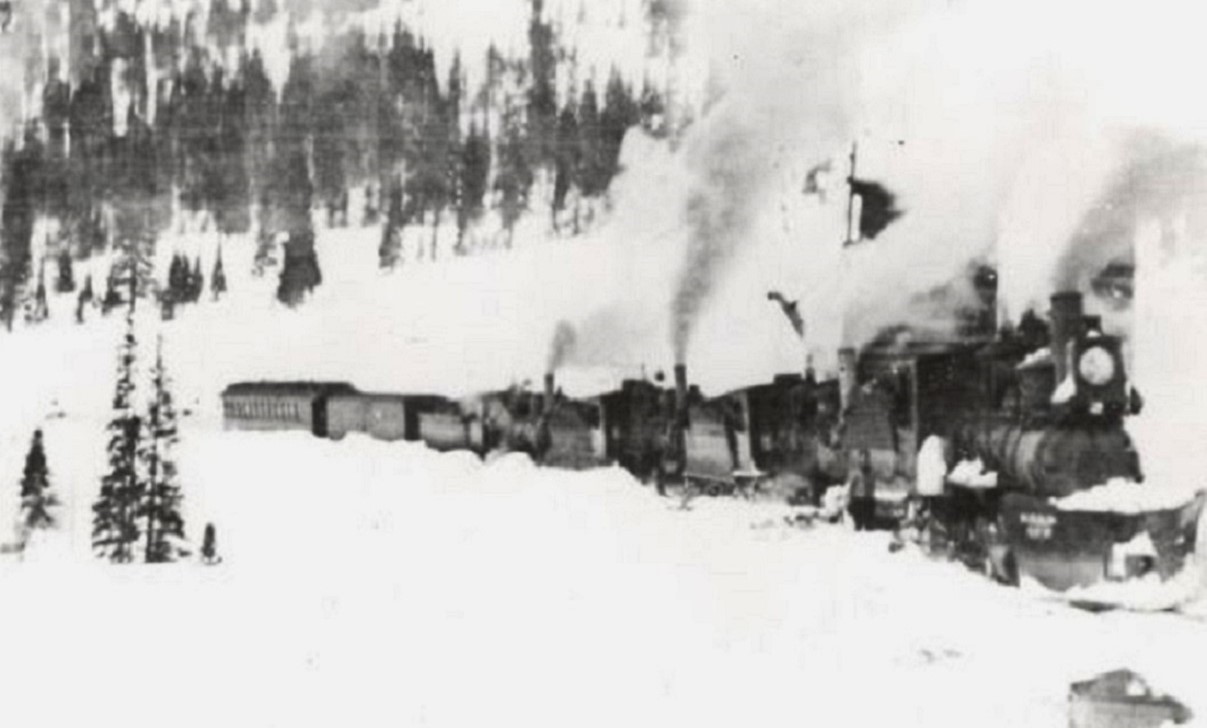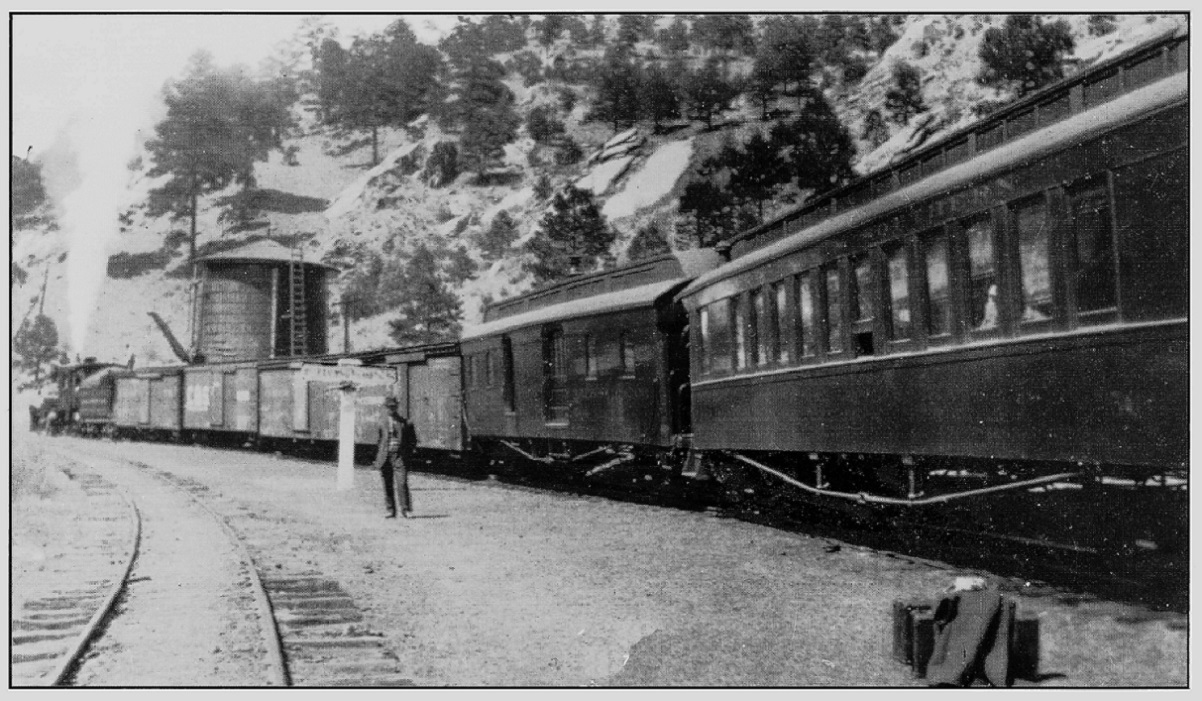Re: C&S Narrow Gauge Employee Timetables
Posted by Jim Courtney on Dec 02, 2024; 12:47am
URL: http://c-sng-discussion-forum.254.s1.nabble.com/C-S-Narrow-Gauge-Employee-Timetables-tp20302p20348.html
Good points as to "mixed trains", Geoff.
Keith asked: Jim, do photos of the era indeed reflect 80-81 running as mixed trains? Seems like all I recall are two car passengers with main-express/ or baggage, depending upon the year.
I dunno, Keith. Until Chris posted Timetable No. 10, I've never looked for them, so I wouldn't have recognized them if I did. Up until now, I've labored under the conventional wisdom that C&S Denver-Leadville passenger trains were always straight passenger consists. I re-read Gordon Chappell, et al.'s comments in the Rail Annual on the South Park Line. They indicated that the Leadville passenger was a straight passenger consist in the first decade, usually three cars (RPO-baggage, 2nd class (smoker) coach, and a first class coach for the ladies and non-smokers. Sometimes the consist increased to four cars.
The Rail Annual stated that on November 1, 1910, (less than a month after timetable No. 10 was published) the new C&S management suspended all train service over Boreas pass, likely using the first substantial snow fall as an excuse. Through Denver-Leadville passenger service was not resumed until January 31, 1913--public pressure forced the Colorado Railroad Commission to order the C&S to restore that service.
During the 27 month suspension of service, passenger service to Breckenridge was provided as a daily passenger turn, Leadville to Dillon to Breckenridge and back:

Consist heading north along the Blue River is Rhode Island C&S 61, an RPO /smoker coach (C&S 41-43) and a first class coach. I have no idea what was happening on the Denver to Como run at this period of time.
The Rail Annual states that when through Denver to Leadville passenger service was restored in 1913, it was daily except Sunday, and that the RPO did not run through past Como. The Denver - Como segment was daily 7 days a week. With this new info, it is not clear whether these trains were mixed trains or straight passenger. Possibly both, full passenger trains April-October (when the tourists were out and about), possibly mixed trains October through April.
As to photos of mixed trains in the 1910-1912 era I reviewed my files and came up with a couple of possibilities:

This photograph is from the Klingers' Highline Memories . . . book. A snowy scene with a mixed train of sorts. Four locomotives taking Water at Baker's Tank, trailed by what looks to be a reefer and a single coach. The locomotives all have shotgun stakes without spark arrestors and the other locomotive headlights and appliances seem consistent with 1910. But I've taken this as a "snow train", bucking snow to clear Boreas, with a reefer for tools and provisions that would not freeze and a coach for the section men to ride in until it was time to get out and shovel snow.
This photo, published in the Klingers' last book is more convincing for a 1910 mixed train:

A C&S westbound mixed train takes water at Crossons in Platte Canon. The caption in the book dates the photo to the 1920s which was puzzling to me. With Chris's posting of Timetable No. 10, I've spent some time studying the photo. I believe there are many clues that the photo dates to 1910-1912:
--The locomotive is indistinct but I can make out a butterfly plow and what looks to be a horizontal air tank atop the fireman's running board, c/w a rebuilt Cooke 2-6-0, regular passenger power at that time. There is no evidence of any spark arrestor on the stack. The "Como" arrestors started showing up 1912-1913.
--None of the four boxcars in the consist have USSA grab irons and stirrups on both ends--these were applied 1914-1916. Three of the boxcars (with horizontal boards covering the side door rails) are St. Charles cars from the 1897 and 1898 orders. Two of the three still seem to carry faded "The Colorado Road" lettering. The third, just ahead of the RPO still carries the original factory lettering from St. Charles. The 4th boxcar, with the big C&S block monogram, seems recently painted, has a different roof, is taller and rides a bit higher above the rails than the St. Charles box cars. I believe it is one of the phase 2 boxcars, outshopped in 1907 and 1908.
--Note that the former UPD&G RPO-express car (C&S 10-11-12) has no end platforms. There is a growing body of photographs suggesting that the head end cars lost their end platforms as early as 1902, many (if not most) by 1910. But the RPO has not yet been rebuilt to its final configuration, complying with the new 1912 USPS guidelines for narrow gauge 15' RPO compartments. That rebuilding is assumed to have happened between late 1912-1913.
--Finally, the coach has clerestory screened windows in a triplet arrangement, suggesting it is one of the three second class coaches 53-54-55. Notice that the car number is above the bolster, not the center of the car, per the 1906 re-numbering convention. Is there a first class coach following, out of frame to the right, bringing up the rear of the train?? who knows . . .
So, IMHO, everything in the photo is consistent with a date of 1910-1912, and the consist may be typical of the mixed train consists noted in the Timetable No. 10. Since I'm most interested in the summers of 1909 and 1924, I don't know as much as I should about the C&S in the early 'teens. When I have some more time, I intend to read through the "Highline" volume of the Documentary History Series to try to glean more of how operations worked in that era of great change to the South Park division.
URL: http://c-sng-discussion-forum.254.s1.nabble.com/C-S-Narrow-Gauge-Employee-Timetables-tp20302p20348.html
Good points as to "mixed trains", Geoff.
Keith asked: Jim, do photos of the era indeed reflect 80-81 running as mixed trains? Seems like all I recall are two car passengers with main-express/ or baggage, depending upon the year.
I dunno, Keith. Until Chris posted Timetable No. 10, I've never looked for them, so I wouldn't have recognized them if I did. Up until now, I've labored under the conventional wisdom that C&S Denver-Leadville passenger trains were always straight passenger consists. I re-read Gordon Chappell, et al.'s comments in the Rail Annual on the South Park Line. They indicated that the Leadville passenger was a straight passenger consist in the first decade, usually three cars (RPO-baggage, 2nd class (smoker) coach, and a first class coach for the ladies and non-smokers. Sometimes the consist increased to four cars.
The Rail Annual stated that on November 1, 1910, (less than a month after timetable No. 10 was published) the new C&S management suspended all train service over Boreas pass, likely using the first substantial snow fall as an excuse. Through Denver-Leadville passenger service was not resumed until January 31, 1913--public pressure forced the Colorado Railroad Commission to order the C&S to restore that service.
During the 27 month suspension of service, passenger service to Breckenridge was provided as a daily passenger turn, Leadville to Dillon to Breckenridge and back:

Consist heading north along the Blue River is Rhode Island C&S 61, an RPO /smoker coach (C&S 41-43) and a first class coach. I have no idea what was happening on the Denver to Como run at this period of time.
The Rail Annual states that when through Denver to Leadville passenger service was restored in 1913, it was daily except Sunday, and that the RPO did not run through past Como. The Denver - Como segment was daily 7 days a week. With this new info, it is not clear whether these trains were mixed trains or straight passenger. Possibly both, full passenger trains April-October (when the tourists were out and about), possibly mixed trains October through April.
As to photos of mixed trains in the 1910-1912 era I reviewed my files and came up with a couple of possibilities:

This photograph is from the Klingers' Highline Memories . . . book. A snowy scene with a mixed train of sorts. Four locomotives taking Water at Baker's Tank, trailed by what looks to be a reefer and a single coach. The locomotives all have shotgun stakes without spark arrestors and the other locomotive headlights and appliances seem consistent with 1910. But I've taken this as a "snow train", bucking snow to clear Boreas, with a reefer for tools and provisions that would not freeze and a coach for the section men to ride in until it was time to get out and shovel snow.
This photo, published in the Klingers' last book is more convincing for a 1910 mixed train:

A C&S westbound mixed train takes water at Crossons in Platte Canon. The caption in the book dates the photo to the 1920s which was puzzling to me. With Chris's posting of Timetable No. 10, I've spent some time studying the photo. I believe there are many clues that the photo dates to 1910-1912:
--The locomotive is indistinct but I can make out a butterfly plow and what looks to be a horizontal air tank atop the fireman's running board, c/w a rebuilt Cooke 2-6-0, regular passenger power at that time. There is no evidence of any spark arrestor on the stack. The "Como" arrestors started showing up 1912-1913.
--None of the four boxcars in the consist have USSA grab irons and stirrups on both ends--these were applied 1914-1916. Three of the boxcars (with horizontal boards covering the side door rails) are St. Charles cars from the 1897 and 1898 orders. Two of the three still seem to carry faded "The Colorado Road" lettering. The third, just ahead of the RPO still carries the original factory lettering from St. Charles. The 4th boxcar, with the big C&S block monogram, seems recently painted, has a different roof, is taller and rides a bit higher above the rails than the St. Charles box cars. I believe it is one of the phase 2 boxcars, outshopped in 1907 and 1908.
--Note that the former UPD&G RPO-express car (C&S 10-11-12) has no end platforms. There is a growing body of photographs suggesting that the head end cars lost their end platforms as early as 1902, many (if not most) by 1910. But the RPO has not yet been rebuilt to its final configuration, complying with the new 1912 USPS guidelines for narrow gauge 15' RPO compartments. That rebuilding is assumed to have happened between late 1912-1913.
--Finally, the coach has clerestory screened windows in a triplet arrangement, suggesting it is one of the three second class coaches 53-54-55. Notice that the car number is above the bolster, not the center of the car, per the 1906 re-numbering convention. Is there a first class coach following, out of frame to the right, bringing up the rear of the train?? who knows . . .
So, IMHO, everything in the photo is consistent with a date of 1910-1912, and the consist may be typical of the mixed train consists noted in the Timetable No. 10. Since I'm most interested in the summers of 1909 and 1924, I don't know as much as I should about the C&S in the early 'teens. When I have some more time, I intend to read through the "Highline" volume of the Documentary History Series to try to glean more of how operations worked in that era of great change to the South Park division.
Jim Courtney
Poulsbo, WA
Poulsbo, WA
| Free forum by Nabble | Edit this page |